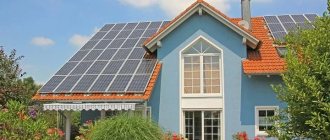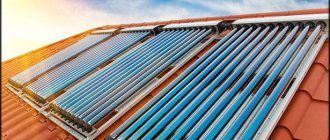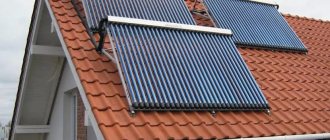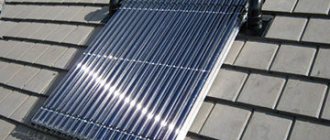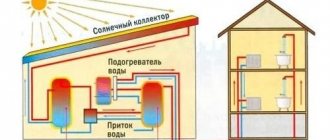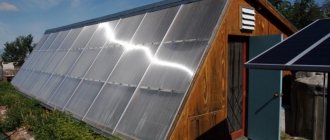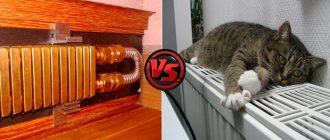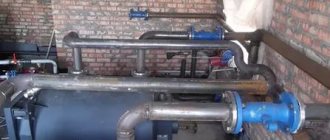Ideas on how to save money, but at the same time have all the benefits of civilization on a personal plot without a centralized electricity and water supply, do not give “homemade” people peace. But often, when it comes to engineering equipment running on “green” energy, developers brush it off. They say that all this is not suitable for our latitudes and harsh natural conditions with short summers, frequent rains and a small number of truly hot days. However, the experience of FORUMHOUSE users suggests the opposite.
From this article you will learn:
- How to assemble an inexpensive solar collector with your own hands.
- Is there any economic benefit from a solar collector installed in the Moscow region?
What's happened
A solar power plant is a modern, environmentally friendly way to obtain and subsequently use thermal energy from the sun. In many countries, installations have long been used in the private sector and on an industrial scale. The systems are suitable for water heating or heating. Benefits for the owner:
- The owner of the installation receives solar energy for free, which he can then distribute throughout the house.
- The process of obtaining and converting energy is environmentally friendly and does not harm the planet.
- The sun's energy is inexhaustible, so the owner of the installation can always be sure of receiving it.
- Compared to other alternative energy plants, the cost of the collector is low.
Like any installation, the solar collector also has its disadvantages - the result of the work depends on the weather.
In our country, the use of solar systems is not as widespread as in Europe and America, due to low efficiency associated with weather conditions. The leaders in the installation of solar collectors today are Japan and China.
What does a solar collector consist of and how does it work?
Each solar collector includes the following elements:
- collector for energy collection;
- circulation pumps;
- pipeline where the coolant circulates;
- installation control system;
- coolant;
- boiler.
The solar installation is compatible with water heaters and gas boilers. Additionally, a heat meter is installed, which helps calculate the energy generated and calculate the real savings of kilowatts.
1. Solar collector. 2. Buffer tank. 3. Hot water. 4. Cold water. 5. Controller. 6. Heat exchanger. 7. Pump. 8. Hot flow. 9. Cold flow.
Vacuum modification
The device contains in its design many tubes made of copper. They are arranged evenly in rows. A tube containing substances with absorbing and reflecting effects is installed in a large diameter glass tube-flask.
Between their walls there remains a space with a vacuum. It plays the role of a heat insulator and conductor of energy. Vacuum collectors have a larger solar energy absorption area, and therefore they have high efficiency.
Varieties
All devices can be divided into 2 categories: according to the heating principle and the method of storing the coolant. When choosing a solar system, you should always choose based on the usage parameters. Depending on the design, the method of operating and maintaining the equipment differs.
Manifolds with built-in tank
Monoblock installations are designed for operation in the spring-autumn period. They are turned off during the winter months. Models with a built-in tank are easy to install and use. All you need to do is connect it to the water supply system.
Principle of operation:
- the sun's rays fall on the absorbing panel (absorberum);
- the resulting energy is transferred to the coil, which is located in the tank;
- thermal energy is transferred from the coolant to the water.
On a good sunny day, such a collector can heat up to 200 liters of water. Collectors with a built-in tank operate without pressure, so installation is carried out at the highest point - the roof of the house. This is done to ensure the necessary water pressure.
Such installations are in wide demand due to their ease of use and easy installation. Most often they are used for summer houses and summer cottages.
The main operating principle is water circulation. Warm water at the top, cold at the bottom. During installation, it is important to install the liquid container above the collector.
Solar systems with a remote tank
These types of collectors can operate all year round. The only condition is that the temperature should not fall below -50 degrees. An external indirect heating boiler is used to heat water, and antifreeze is used as a coolant.
Principle of operation:
- the absorbing panel receives heat and transfers it to the coolant;
- under pressure, the coolant enters the heat exchanger of the storage tank;
- As the antifreeze passes through the coil, it heats the water.
Such solar systems work with a connection to a pumping group. Management is carried out automatically.
The advantage of a solar collector with a remote tank is the ability to generate energy all year round, under certain conditions. However, such installations require the connection of additional equipment, and the operation of the collector depends on electricity - its disconnection may affect the operation of the installation.
Classification according to temperature criteria
There are quite a large number of criteria by which certain solar system designs are classified. However, for devices that can be made with your own hands and used for hot water supply and heating, the most rational option would be to separate them by type of coolant.
So, systems can be liquid and air. The first type is more often applicable.
Image gallery
Photo from
Step 1: Assembling the Corrugated Pipe Manifold
Step 2: Painting the Solar Instrument Black
Step 3: Installing Air Connections
Step 4: Making a cover for the solar device
In addition, a classification is often used based on the temperature to which the working components of the collector can be heated:
- Low temperature. Options capable of heating the coolant up to 50ºС. They are used to heat water in irrigation tanks, in bathtubs and showers in the summer and to improve comfortable conditions on cool spring-autumn evenings.
- Medium temperature. Provide a coolant temperature of 80ºС. They can be used to heat rooms. These options are most suitable for furnishing private homes.
- High temperature. The coolant temperature in such installations can reach up to 200-300ºС. They are used on an industrial scale, installed for heating production workshops, commercial buildings, etc.
High-temperature solar systems use a rather complex process of transferring thermal energy. In addition, they occupy an impressive amount of space, which most of our lovers of country life cannot afford.
The manufacturing process is labor-intensive, and implementation requires specialized equipment. It is almost impossible to make such a version of a solar system on your own.
It is quite difficult to make high-temperature solar panels using photovoltaic converters at home
Kinds
Depending on the operation, the following types of solar installations can be distinguished: flat, vacuum, air. Let's take a closer look at each of them.
Flat
The panel is airtight and consists of several elements:
- The absorption plate or absorber is directly connected to the heat-conducting system. Covered with black paint or special coating.
- The clear cover is made from polycarbonate or low-metal tempered glass.
- Thermal insulating layer. The coolant tubes are made of copper or cross-linked polyethylene.
The principle of operation is simple - the absorber heats up and transfers heat to the coil in which the coolant is located. The unit is easy to install and use.
Advantages:
- low cost;
- the ability to install the system at any angle;
- high efficiency in the warm season;
- There is no need to manually clear the installation of snow and frost.
The only significant disadvantage of the system is the high level of heat losses. To minimize losses, insulation materials are used, for example, vinvata. However, this is not the best way if the temperature inside and outside the case is very different. Therefore, such installations are ineffective for operation in the cold season.
Vacuum
A vacuum or tubular manifold has a more complex design. The panel consists of many glass tubes with an absorber inserted inside. Each tube is completely evacuated, so it retains up to 97% of heat. Such collectors are used all year round; they are able to operate efficiently at temperatures down to -37 degrees.
Advantages:
- low heat loss;
- work at low temperatures;
- low windage of the structure;
- easy installation.
Flaws:
- working installation angle 20 degrees;
- It is necessary to clean solar systems from snow and frost.
Air
They are a heat absorber, and air acts as a coolant. The principle of operation is simple: cold air enters the duct system, heats up and exits into the ventilation pipe system. There, warm air can be distributed in the desired direction. Advantages of a solar system:
- fast air heating;
- no need to use electricity or gas.
Flaws:
- Collectors operate only in sunny weather. In cloudy weather the efficiency is practically zero.
- During installation, it will be necessary to drill holes in the wall or roof, depending on the installation location.
Airborne solar collectors are now widely used among owners of private houses. Their use is an additional source of heating and air ventilation.
From copper tubes
A collector with a copper coil, lined on the inside with sheets of the same material, is extremely effective. Perhaps the most effective one we found on the Internet. Tubes and strips are soldered with a special autogenous soldering iron at seams and joints, so the copper absorber was the most labor-intensive stage, taking 2 days.
Copper was blackened by placing it in a bath of potassium persulfate:
The case was insulated, and foil was attached to the back wall to reflect heat. All gaps were carefully sealed:
The structure was moved to its place, for this it was wrapped in ordinary cling film, and only after transportation and connection was the glass installed:
Result: in the hot southern climate, under direct rays, the copper became hot, the water heated to a boil, and there were even noticeable traces of melting of the polymer structural elements. It is advisable to add cold liquid to a shower with a solar absorber of this type, for which purpose provide a separate barrel with it or a supply from the tap.
The principle of operation of the solar collector
The principle of operation is simple - the installation converts solar energy into heat. How it works: absorbing plates attract and retain sunlight, which in turn heats the coolant. The plates are black in color because it does not reflect, but absorbs the rays that fall on it. Using a pump, the heated liquid transfers heat to the tank. In good sunny weather, the solar system can provide the daily need for warm water.
Effective work is influenced by:
- length of day;
- cloud level;
To make the collector's efficiency coefficient higher, additional equipment is installed - gas boilers, heat pumps.
What do solar systems run?
The coolant for solar systems is charged depending on the type and operating conditions. If the collector operates all year round, it is necessary to fill it with an antifreeze compound; if the season is spring - autumn, then filling it with distilled water is suitable.
if the collector is used in winter, then a mixture of propylene glycol with water and anti-corrosion substances is suitable for refueling. The proportion of the solution depends on the conditions in which the system is used:
- at temperatures below 20 degrees, the proportion is as follows - add 6 liters of propylene glycol to 10 liters of coolant;
- at temperatures below 30 degrees, the solution is made in equal proportions.
You can immediately buy ready-made antifreeze, diluted in the required proportions.
Important: you cannot use water as a coolant in winter, as it will freeze and burst the pipes. Therefore, at the end of the season, the water must be drained from the installation.
How does a solar collector work in winter?
Perhaps, due to inaccurate information, a large percentage of the population ignores an alternative method of obtaining energy. The most common misconception is that the collector cannot work effectively in winter. But it is not so. The main theories put forward by opponents of solar systems:
- The need to clean the installation from snow and ice in winter so that it can operate efficiently.
- On cloudy days the installation is useless.
- At sub-zero temperatures, the collector will not be able to generate the required amount of energy.
There is some truth in these beliefs, but not all of them. When choosing a collector, you need to take into account where it will be installed, during what period of time it will work and other factors.
For example, vacuum collectors continue to operate even in diffuse light. Their efficiency is lower than in direct sunlight, but the work process does not stop.
If the vacuum collector panel is covered with snow, then its operation is reduced by 10-15%, while the snow melts off from flat solar installations on its own.
The appearance of ice or frost on the collector does not interfere with the process, so light transmittance remains good.
Please note: if you compare the efficiency of a collector in winter and summer, the efficiency of a vacuum collector drops by 10-15%, and a flat one by 40%.
How much water can a solar collector heat?
To answer this question, you need to take into account several factors: what season and weather conditions it is, what heating method is used. Taking into account all factors, data may change. For 1 square meter of solar system, the following heating capability per hour is considered to be:
- 100 liters at 7 C;
- 50 liters at 14 C;
- 25 liters at 28 C;
- 15 liters at 46 C;
- 10 liters at 70 C.
For a larger amount of water, install a storage tank.
Where is the best place to place the solar collector?
Solar systems are powered by solar energy, so it is logical that they should be placed outside the house on the sunny side of the site or roof. Both flat and sloping roofs are suitable for mounting the plates. Collectors are heavy; it is recommended to mount them on supporting beams. In our latitudes, it is recommended to install structures on the south side. Even a small deviation will give less energy productivity.
It is important to install the collector at the correct angle, this is due to the fact that the sun's rays fall on the earth's surface under a certain refraction. The following factors need to be taken into account:
- Location. For the southern regions, the angle of inclination is approximately 30-35 degrees, for the northern regions - 40 degrees.
- If the installation will be used all year round, then the angle is approximately equal to the latitude of the area. If only in summer - the value is increased by 15 degrees, in winter - reduced by 15 degrees.
All data is approximate, so it is better to calculate the installation based on the specific area. The operating instructions will indicate the average values for a specific collector. You need to choose a location so that no shadow from trees or neighboring buildings falls on the collector plates.
Please note: the best option is installations with automatic angle adjustment.
What you need to know about solar power
The choice of solar installation power depends on the operation - year-round or seasonal, what volume of generated energy is needed and other factors.
If the primary purpose of the installation is to heat water, then you can choose systems with lower power. If the system will be involved in heating the house, then higher power is needed.
Average: a collector area of 4-6 square meters is enough to provide half the house with hot water. To fully provide the house with thermal energy, you will need at least 12 square meters of the system.
How to protect the solar collector from overheating
Overheating of the solar collector leads to partial or complete breakdown and subsequent repairs. To avoid this, you must follow the following recommendations:
- Correctly calculate the area covered by the plates. Unscrupulous sellers may advise buying more plates to generate energy than is needed for consumption. It must be taken into account that in summer the heating rate is higher than in winter.
- If necessary, discharge hot water into the sewer. This is done automatically when the temperature reaches the limit.
- Covering the collector with a roller shutter. When the water temperature in the boiler reaches the desired temperature, the curtain automatically lowers and covers the plates. When hot water is needed again, the roller shutter opens and the plates begin to absorb the sun's rays again.
By following a few recommendations, you can protect your solar system from repairs.
Advantages
A solar collector for heating water has a lot of positive qualities:
- saving energy resources. In summer, the system can fully provide the facility with hot water. In spring and autumn, when solar energy is not enough, collectors act as an addition to the boiler, reducing the load and saving fuel;
- autonomy. By installing a solar collector, you become independent from the supply of energy resources (gas, electricity, etc.). You don't have to pay for them all the time;
- availability. There is a wide variety of such systems on the market. There is no need to obtain any permits to install them;
- durability. Collectors serve uninterruptedly for at least 15 years.
Solar collector for water heating
Solar water heating systems are the most common option for using solar energy and can be used all year round. There are some nuances in connection, operational efficiency and care. Let’s take a closer look at how the collector connection diagram differs in winter and summer.
Summer option for hot water supply from a solar collector
Installation of the unit for operation in the warm season is not difficult. Most often they are installed for a summer shower or to provide a country house with hot water.
If the water will be used outside, as is the case with a summer shower, then the tank should also be located outside. If water supply is required in the house, then the tank is installed there.
In such installations, natural circulation of liquid occurs, so the following recommendations must be adhered to:
- The collector battery is installed slightly below the level of the tank where hot water will flow.
- To connect the tank to the collector, tubes no smaller than 7.5 centimeters are used.
For efficient operation, a circulation pump is sometimes used.
Winter connection diagram for solar water heating
If the solar system is used all seasons, then you need to remember that you cannot use water as a coolant, as it will freeze and break the pipes. To use the installation in winter, antifreeze is used. The installation diagram will look like this:
- An indirect heating boiler is installed.
- The antifreeze heats up and passes through the coil and warms the water that is currently in the tank.
- For control, an expanded tank, an automatic air vent, and a safety valve are installed.
The efficiency of solar systems in winter is lower compared to energy production in summer.
From a refrigerator radiator
There is a description on the Internet of a homemade solar collector with a refrigerator radiator. The manufacturing process as a whole is described above; let us briefly recall the main points:
- You can place reflective material (foil) in the inner surface of a tightly closed insulated box, but here it is fixed on a black rubber mat. This is also an effective option, since a dark color attracts rays better and accumulates heat.
- We place the coil inside the body, cover it with glass (you can use screws as stops), and place it so that the rays fall at right angles.
- We connect the PP pipes to the inlet for cold water and the outlet to the shower tank for warm water. And also the liner can be the most basic - from flexible, rubber hoses.
- Shower tank - any suitable container.
Advantages and disadvantages of solar collectors for heating water
Having examined the various types of collectors, we can highlight the advantages and disadvantages of using such systems on our site.
Advantages:
- The sun is a free and inexhaustible source of alternative energy.
- Solar systems are an environmentally friendly method of energy production.
- Savings can be up to 100% in the warm season.
- Solar collectors operate all year round.
- The collector systems are easy to maintain and install.
- The operation of the installation does not depend on increases in gas prices.
- Service life is about 30 years.
Flaws:
- Not everyone can buy even inexpensive collector models.
- The operation of the solar system is completely dependent on the weather.
- When installing, you need to correctly calculate the installation location of the system and install it at the correct angle for proper operation. Avoid the shadows of trees and buildings falling on the absorbing panel.
Despite the shortcomings, the efficiency of solar systems outweighs. Many are switching to an alternative energy source, if not completely, then partially.
